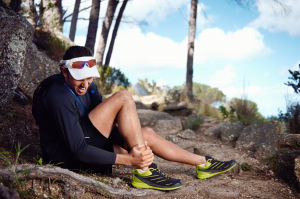
The Achilles tendon is the most common tendon to rupture spontaneously. In athletes, it is the most commonly hurt tendon of the lower extremities. About 24% of competitive athletes and 40% of runners experience an Achilles tear at some time. In short, injuring the Achilles is certainly not rare. But that doesn’t mean it shouldn’t be taken seriously. Here’s everything you need to know about the physiology of the Achilles tendon, types and symptoms of Achilles injuries, treatment options, and the best prevention practices.
Physiology
The Achilles tendon is a tough, fibrous band of tissue that runs from the calf to the heel. More specifically, the Achilles unites the gastrocnemius and soleus muscles of the back of the calf and connects them to the calcaneus (heel bone). Small fluid bursae sacks cushion the tendon at the heel. The Achilles in the largest and strongest tendon in the entire body. Consequently, a massive amount of tension is placed on it in order to walk, run, jump, or tip-toe, and it is very prone to injury.
Common Achilles’ Injuries
While the majority of Achilles injuries are sustained by athletes, they can really happen to anyone in varying degrees of severity.
The most serious damage that can occur is a complete rupture of the tendon. This is characterized by a “popping” sound and sharp, immobilizing pain. Treating a rupture often requires surgery and a long-term recovery process. Based on severity, surgery can be minimally invasive (through a scope), or require partial/total replacement of the tendon.
The next most severe injury is a partial tear. Achilles tears can be tiny (microtears) or quite big. They can occur suddenly, or over time. Symptoms of tears include swelling, pain, stiffness, sensitivity, the feeling of being “kicked in the calf”, and the inability to fully bend the foot downward.
Achilles tendonitis is another possible injury. This is a type of strain and degeneration caused by overuse, usually from running or another repetitive exercise. Tendonitis begins with a mild chronic pain, stiffness, or swelling, and can worsen without proper treatment. Luckily, if handled quickly, tendonitis can usually be resolved in a matter of weeks.
Preventing Achilles Tear
While some Achilles injuries are simply unpreventable, you can reduce your risk by taking proper precautions. For athletes, this includes:
- Wearing proper shoes. Worn-out trainers won’t cushion your feet properly and can increase your risk of injury. Regularly replacing your shoes is a must-do.
- Stretching daily. A couple minutes of stretching helps maintain flexibility.
- Doing cross-training and strength training. Diversifying your exercise routine can better prepare your Achilles for stress.
- Taking your rest. Overtraining is a huge risk factor for Achilles tendon injuries. Gradually increasing the intensity of your activity or following a balanced fitness plan is the way to go.
- Knowing your risk factors. If you are a male, an athlete, or an older adult, you already are more likely to be injured. Having a naturally flat arch or being overweight can also put more pressure on the Achilles. Certain medical conditions and medications can also increase your risk, such as having psoriasis or high blood pressure, or taking antibiotics like fluoroquinolones.
If you are experiencing chronic Achilles pain or an injury, it is advisable that you consult a qualified medical professional for diagnosis and treatment. For those in the Louisville, Kentucky region, orthopaedic surgeon and sports medicine physician Dr. Stacie Grossfeld is accepting new patients. Call 502-212-2663 for more information or to schedule an appointment.

Recent Comments